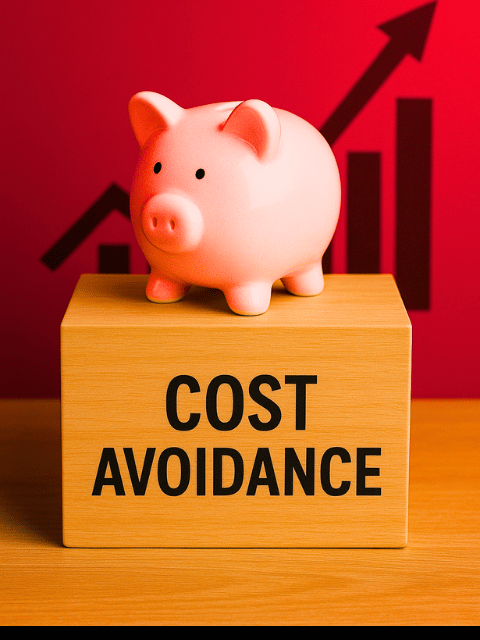15 Oct 2025
Cost Avoidance: Preserving Liquidity and Protecting ROCE in Manufacturing

Manufacturers are operating in a climate where volatility is the default setting. FX fluctuations, commodity price instability, rising logistics costs and tightening credit conditions all converge to squeeze margins. For finance leaders, this translates into a sharper focus on capital discipline and cash flow visibility.
Traditional cost-cutting exercises, decreasing budgets or deferring spend, often provide temporary relief, but at the expense of operational resilience. Short-term savings can quickly be offset by the longer-term cost of unplanned downtime, emergency procurement, or diminished supplier loyalty.
The more sustainable solution is cost avoidance, the proactive interception of spend before it crystallises on the P&L. It is less about reacting to expense lines and more about redesigning processes to prevent unnecessary outflows altogether and to keep avoiding them in the future. For finance directors and managers, this approach strengthens liquidity while safeguarding operational continuity.
Why Cost Avoidance Matters to Finance Teams
The impact of cost avoidance extends far beyond OPEX management. It directly influences working capital ratios, liquidity buffers, and ROCE. Every transaction dollar avoided is a dollar of optionality retained on the balance sheet, redeployable into higher-yielding opportunities.
Key advantages include:
- Working Capital Optimisation: Slow-moving, obsolete or unnecessary MRO stock inflates current assets without contributing to productive output. By eliminating these inefficiencies, finance teams improve the cash conversion cycle and release tied-up liquidity.
- Liquidity Preservation: In developing markets where access to external finance is limited or costly, avoiding unnecessary procurement spend provides immediate relief to operating cash flow.
- Cost of Capital Mitigation: Releasing trapped capital reduces dependency on short-term debt and insulates businesses from rising interest rate environments.
- Avoided P&L Erosion: By intercepting unapproved purchase orders, duplicate SKUs, and redundant freight, costs never flow through to EBITDA, improving reported margins.
How It Works in Practice
Effective cost avoidance is grounded in robust MRO governance and cross-functional alignment between finance and operations. The levers typically include:
- Supplier Rationalisation: Consolidating the vendor base to unlock economies of scale, negotiate stable pricing, and reduce transactional inefficiency.
- Contractual Term Negotiation: Extending credit periods improves free cash flow and strengthens return on capital employed (ROCE).
- Min/max reset: Evidence based financial assessment of MRO holding levels and order quantities stops unnecessary orders being placed, immediately allowing avoided spend to be utilised in the rest of the business.
- Duplicate SKU Control: Standardising item masters reduces procurement errors, minimises inventory misstatements, and avoids inflated carrying costs.
- Freight & Duty Optimisation: Streamlining logistics lowers landed costs, particularly impactful in regions where import tariffs and shipping volatility erode profitability.
In a recent engagement, Entec International worked with a global premium drinks manufacturer to avoid over USD 1 million of planned MRO spend within six months — a 23% variance against forecast. Crucially, this was achieved while maintaining uptime and protecting service levels.
👉 Read the full case study here
The Strategic Finance Angle
The implications for finance leadership are clear:
- Enhanced ROCE through redeployment of avoided spend into strategic CAPEX or growth initiatives.
- Stronger balance sheet discipline by reducing the volume of non-productive current assets.
- Improved liquidity coverage ratios, reducing exposure to high cost borrowing in constrained credit markets.
- Sustained P&L integrity, ensuring unnecessary costs are neutralised before recognition and permanently avoided
Cost avoidance is therefore not merely an operational tactic, it is a finance-led strategy that directly influences enterprise value, resilience, and long-term competitiveness.
Finance-Led Resilience
In today’s environment, capital discipline is non-negotiable. Manufacturers that embed cost avoidance into their financial governance frameworks position themselves to fund growth internally, protect against volatility, and deliver enhanced returns to stakeholders.
For finance leaders, cost avoidance is more than an efficiency play. It is a structural advantage, one that preserves liquidity, optimises working capital, and strengthens ROCE without compromising uptime.
Lower costs. Boost performance. Make your cash work for you.
Latest News
-
15 Oct 2025
Cost Avoidance: Preserving Liquidity and Protecting ROCE in Manufacturing
-
1 Aug 2025
The strategic shift: Why African manufacturers are going global with MRO
-
4 Jul 2025
Our commitment to reducing our carbon footprint
-
9 May 2025
How Latin American manufacturers can future-proof their spare parts strategy
-
21 Feb 2025
Rethinking MRO Procurement: Moving Beyond the Status Quo

Get in touch
Have questions or need more information about our solutions? We’re here to help. Whether you’re looking to optimise your MRO processes or explore tailored services for your business, our team is ready to assist. Click below to reach out through our contact form, and one of our specialists will get back to you promptly. Let’s work together to achieve your operational goals.
